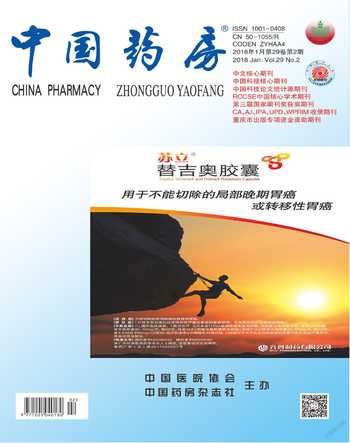全球抗菌药物使用监测现状的循证评价
曾力楠 张祚洁 张伶俐 黄亮 归舸
中图分类号 R978.1;R969.3 文献标志码 A 文章编号 1001-0408(2018)02-0145-07
DOI 10.6039/j.issn.1001-0408.2018.02.01
摘 要 目的:为我国抗菌药物使用监测工作的持续改进提供循证依据。方法:通过检索Medline、Embase、Cochrane Library等3个生物医学文献数据库和48个卫生行政部门和学术机构网站,搜集抗菌药物使用监测网/项目的相关文献,提取其基本信息及数据采集、分析和报告方法等内容,采用描述性分析方法,分析全球抗菌药物使用监测网/项目的现状。结果:最终纳入文献21篇,共涉及抗菌药物使用监测网/项目16个,其中国际级3个、国家级13个,以欧洲(国家)为主(56.25%,9/16)。16个监测网/项目均旨在监测并比较抗菌药物使用情况,分析抗菌药物使用趋势及其与细菌耐药的相关性,评价抗菌药物管理政策的实施效果。負责机构以卫生行政部门为主,资助机构以政府相关部门为主。现有监测网/项目以医院和社区为主要监测对象,针对儿童抗菌药物使用的监测网/项目有2个,包含儿童用药数据的有6个,但仅有瑞典Strama单独分析了儿童用药数据。公布数据采集方法或内容的监测网/项目共14个,数据采集以主动上报为主,涉及药品使用/消耗、人口/患者两类数据。除ESAC-Net、ARPEC、NAUSP外,其余监测网/项目均未提及数据校验方法。数据分析以医疗机构和抗菌药物类别分类最为常见,限定日剂量是计算抗菌药物消耗量最常用的统计指标。公布监测报告的监测网/项目有10个,多以年报形式发布。结论:抗菌药物使用监测已在全球广泛开展,但尚缺乏包括儿童在内的特殊人群抗菌药物使用监测与分析;另外,数据校验是抗菌药物使用监测的薄弱环节,数据采集质量仍有待进一步提高。
关键词 抗菌药物;使用;监测;循证评价
ABSTRACT OBJECTIVE: To provide evidence-based basis for the continuous improvement of antibacterial use surveillance in China. METHODS: Retrieving from 3 biomedical literature databases as Medline, Embase, Cochrane Library, 48 health administrative departments and academic institutions, relevant literatures on antibacterial surveillance networks/projects were acquired and extracted, including basic information, data collection, analysis and reporting methods, etc. Descriptive analysis method was adopted to analyze the status quo of global antibacterial surveillance networks/projects. RESULTS: A total of 21 literatures were included, involving 16 antibacterial surveillance networks/projects. Among them, there were 3 international projects and 13 national projects, mainly in European (countries) (56.25%, 9/16). Sixteen antibacterial surveillance networks/projects were established to monitor and compare the use of antibacterials, analyze the antibacterial use trend and its correlation with bacterial resistance, and evaluate implementation effect of antibacterial management policy. The responsible agencies were mainly the health administrative departments, and the funding agencies were mainly related government departments. Hospital and community were main surveillance objects. There were 2 surveillance networks/projects for antibacterial use in children, and 6 surveillance networks/projects contained medication data of children. Only Strama in Sweden alone analyzed medication data in children. Fourteen surveillance networks/projects promulgated data collection methods or contents; data collection was mainly based on active reporting and involved the data of drug use/consumption and population/patient. Except for ESAC-Net, ARPEC, NAUSP, data validation method was not mentioned in other surveillance networks/projects. Data analysis was most common in medical institutions and antibacterial categories, and defined daily dose was the most commonly used statistical indicators of antibacterial consumption. Ten surveillance networks/projects promulgated surveillance reports which were mostly published annually. CONCLUSIONS: Antibacterial surveillance have been widely operated worldwide. But there is a lack of monitoring and analysis of antibacterial use in special population including children. In addition, data validation is the weak link of antibacterial surveillance, so the quality of data collection still need to be improved.
KEYWORDS Antibacterial; Use; Surveillance; Evidence-based evaluation
抗菌药物耐药指微生物对原本能够有效治疗其所致感染的抗微生物药物产生抵抗[1]。随着新的耐药机制的出现和传播,抗菌药物的耐药形势日益严峻,导致每年全球相关卫生保健支出高达15亿美元[2]。世界卫生组织(World Health Organization,WHO)总干事陈冯富珍女士指出,各国政府已认识到抗菌药物耐药性上升已成为当今最大的公共卫生挑战之一,而抗菌药物滥用是导致其耐药性出现和加剧的重要原因,因此呼吁各国加强抗菌药物使用与耐药监测,促进药物合理使用[3]。鉴于此,本课题组通过系统检索全球抗菌药物使用监测网/项目,比较及分析其监测目的、方法和内容等,以期为我国抗菌药物使用监测工作的持续改进提供参考。
1 资料与方法
1.1 纳入与排除标准
1.1.1 纳入标准 ①文献内容:涉及国际或国家级抗菌药物使用监测网/项目;②发布机构:卫生行政部门、学术机构;③语言:中文或英文。
1.1.2 排除标准 已停止监测工作的抗菌药物使用监测网/项目。
1.2 检索策略
计算机检索Medline、Embase、Cochrane Library等3个生物医学文献数据库以及38个国家和地区的48个卫生行政部门和学术机构相关网站(检索策略见表1),调查抗菌药物使用监测网/项目的现状。数据库检索式为:(Antibiotic or Antimicrobial) and (Surveillance or Monitor*),检索建库开始至2016年3月的相关文献。
1.3 数据提取与分析
制订统一的资料提取表,以10%的文献进行预试验。内容包括:1)抗菌药物使用监测网/项目的基本信息,含监测网/项目的名称、负责机构、组建时间、组建背景与目的、组建过程、组织构架和监测对象;2)数据采集方法,含采集人员、频率、内容、方法及数据校验方法等;3)数据分析方法,含分析人员、频率、内容及方法;4)数据报告方法,含报告名称、机构、频率、内容和形式;5)反馈与改进,含反馈与改进机制和监测效果评估。采用描述性分析方法,分析全球抗菌药物使用监测网/项目的现状。
2 结果
2.1 文献检索与筛选结果
通过检索数据库及卫生行政部门、学术机构网站,共获得文献5 428篇,经筛选,最终纳入文献21篇[4-24]。文献筛选流程及结果见图1。
2.2 抗菌药物使用监测网/项目的基本情况
21篇文献共涉及抗菌药物使用监测网/项目16个[4-24],其中国际级3个、国家级13个,以欧洲(国家)为主(56.2%,9/16),基本情况见表2。16个监测网/项目的目的一致,旨在监测并比较抗菌药物使用情况,分析抗菌药物使用趋势及其与细菌耐药的相关性,评价抗菌药物管理政策的实施效果,为制订相关指南提供参考。负责机构以卫生行政相关部门为主(56.2%,9/16),其次为科研机构(25.0%,4/16)和高校(12.5%,2/16);资助机构以政府相关部门为主(31.2%,5/16)。各监测网/项目负责机构均由多学科人员组成,主要包括药师、医师、统计学专家等。国际级监测网/项目中,各参与国均派协调员参与项目协调和实施[4-7]。现有监测网/项目以医院和社区为主要监测对象,另各有1个监测网/项目分别监测了社区药店和养老院;针对儿童抗菌药物使用的监测网/项目有2个(GARPEC[4]和ARPEC[6-7]),此外包含儿童用药数据的监测网/项目有6个[12-18,24]。
2.3 抗菌药物使用监测网/项目的数据采集及来源
2.3.1 数据采集 公布数据采集方法或内容的监测网/项目共14個,数据采集以主动上报为主。其中,欧洲ESAC-Net[5,22-23]、ARPEC[6-7]和加拿大CIPARS[9]在正式数据采集前先通过预调研评估数据方案。监测内容以抗菌药物使用与消耗的现状和趋势为主,数据采集方式具体包括成员单位上报或数据库采集,包含药品使用/消耗、人口/患者两类数据,较少涉及使用合理性评价,详见表3(表中,采集方法a表示成员单位向监测网/项目上报数据,b表示监测网/项目从数据库中提取数据)。由于CARPEC缺乏相关数据,故未列入该表中。其中,ESAC-Net[5,22-23]、ARPEC[6-7]等采集总体数据,中国CAS[20]采集抽样数据,其余均未见报道。药品数据来源于医疗机构、卫生行政部门、医药信息服务提供商和研究机构,其中医疗机构是其主要来源。但在发达国家,某些医药市场研究公司因已拥有该国主要抗菌药物使用数据,故成为了监测数据主要的来源机构(如加拿大的艾美仕市场研究公司)。
2.3.2 数据校验 数据校验是抗菌药物监测的薄弱环节,除ESAC-Net[5,22-23]、ARPEC[6-7]、NAUSP[19]外,其他监测网/项目均未提及数据校验方法。其中,ESAC-Net[5,22-23]采用系统校验、国家间数据对比和专家校验方式:①数据上报过程中内置校验程序;②数据汇总过程中对比各国数据;③数据核对过程中由专业人员对比往年数据,检查离群值。ARPEC[6-7]通过系统内置程序校验,能在出现错误信息或不完整数值时阻止提取。NAUSP[19]将当月数据与前一年均值进行比较,当差异超过2个标准差时启动数据核查程序。
2.3.3 数据分析 数据分析层次与监测范围、目的相关,以医疗机构和抗菌药物类别分类最为常见;限定日剂量是计算抗菌药物消耗量最常用的统计指标[22],详见表4[表中,“√”表示该监测网/项目涉及此内容;PPS为现患率调查,即研究特定时点或时期和特定范围内人群中的有关变量(因素)与疾病或健康状况的关系;DIDs为每1 000名居民每日的限定日剂量数,即限定日剂量总数×1 000/(居民数×天数);DBDs为每100个床位每日的限定日剂量数,即限定日剂量总数×100/(床位数×天数);DADs为每100名住院患者的限定日剂量数,即限定日剂量总数×100/住院患者数;a为每1 000名居民每日的抗菌药物包装数,即抗菌药物包装数×1 000/(居民数×天数);b为单次住院使用抗菌药物的天数,即使用抗菌药物的总天数/住院人次数;c为每1 000张处方单元的限定日剂量数,即限定日剂量总数×1 000/处方单元;d为每100名患者每日的限定日剂量数,即限定日剂量总数×100/(患者数×天数)]。由于CARPEC缺乏相关数据,故未列入该表中。在特殊人群方面,尽管有6个监测网/项目同时监测了成人与儿童用药数据,但仅瑞典Strama[15-16]单独分析了儿童用药数据。
2.4 抗菌藥物使用监测网/项目的监测报告
公布监测报告的监测网/项目有10个,多以年报形式发布,仅澳大利亚NAUSP[19]、SAAUSP[21]每2月发布1次。欧洲ESAC-Net[5,22-23]和英国ESPAUR[12,24]有监测报告计划书。
3 讨论
细菌耐药已成为全球面临的严重威胁。WHO在2011年提出“遏制耐药——今天不采取行动,明天就无药可用”[25]的倡议,并于2014年5月发布了《控制细菌耐药全球行动计划(草案)》[26],旨在督促各国制订抗菌药物行动计划。该行动计划的五个战略目标之一就是“优化抗菌药物使用”。而作为导致细菌耐药的重要原因,抗菌药物滥用日益受到各国重视。多国已建立了较为完善的抗菌药物使用监测机制,作为控制药物滥用的重要手段。
本研究显示,抗菌药物使用监测已在全球广泛开展。其中,欧洲抗菌药物使用监测网/项目的数量最多(占56.2%),是目前抗菌药物使用监测方法学发展的前沿地区,其抗菌药物使用监测及数据分析、报告的方法值得借鉴;卫生行政部门是全球抗菌药物监测的主要负责机构,其监测对象以社区和医院为主;限定日剂量是全球普遍采用的计算抗菌药物消耗量的统计指标。尽管各地抗菌药物监测已广泛开展,但仍存在以下不足:(1)数据校验是保障数据质量的重要步骤,但现有监测网/项目数据校验实施情况不明,不同监测机构的监测数据质量仍有差距;(2)针对特殊人群(如儿童)抗菌药物使用的监测尚未广泛开展,现有方法用于特殊人群时仍存有局限性[27]。
基于全球抗菌药物发展的现状与趋势,笔者对我国抗菌药物使用监测提出如下建议:(1)完善监测网/项目专家组成员的学科构成,应包含感染学、药学、统计学、信息学等专业人员;(2)建立数据采集预试验机制,每年初公布经预试验后的抗菌药物监测数据采集方案,对各监测点人员开展定期培训,以提高数据采集质量;(3)进一步开展对特殊人群抗菌药物使用情况的监测,如儿童、孕产妇、老年人、重症监护病房患者等,探索特殊人群抗菌药物监测的数据采集和分析方法;(4)定期公开发布抗菌药物使用监测数据,并向各监测点反馈监测结果,以达到通过监测来控制抗菌药物滥用的目的。
[致谢:教育部长江学者创新团队基金(No.IRT0935)、国际合理用药网络中国中心组高风险用药人群药物管理组]
参考文献
[ 1 ] World Health Organization. Antimicrobial drug resistance[EB/OL].[2016-10-25]. http://www.who.int/mediacentre/factsheets/fs194/zh/.
[ 2 ] World Health Organization. Antimicrobial resistance[EB/OL].[2016-10-25]. http://www.who.int/mediacentre/factsheets/antibiotic-resistance/en/.
[ 3 ] World Health Organization. WHO multi-country survey reveals widespread public misunderstanding about antibiotic resistance[EB/OL]. [2016-10-25]. http://www.who.int/mediacentre/news/releases/2015/antibiotic-resistance/en/.
[ 4 ] St Georges University of London. The Global Antimicrobial Resistance, Prescribing, and Efficacy among Neonates and Children (GARPEC)[EB/OL]. [2016-10-25]. http://garpec.org/.
[ 5 ] European Centre for Disease Prevention and Control. European Surveillance of Antimicrobial Consumption Network(ESAC-Net)[EB/OL]. [2016-10-25]. http://ecdc.europa.eu/en/activities/surveillance/ESAC-Net/Pages/index.aspx.
[ 6 ] VERSPORTEN A,BIELICKI J, DRAPIER N, et al. The Worldwide Antibiotic Resistance and Prescribing in European Children (ARPEC) point prevalence survey: developing hospital-quality indicators of antibiotic prescribing for children[J]. J Antimicrob Chemother,2016,71(4):1106-1117.
[ 7 ] VERSPORTEN A, SHARLAND M, BIELICKI J, et al. The antibiotic resistance and prescribing in European children project: a neonatal and pediatric antimicrobial web- based point prevalence survey in 73 hospitals worldwide[J]. Pediatr Infect Dis, 2013, 32(6):e242-e253.
[ 8 ] National Healthcare Safety Network (NHSN). Antimicrobial Use(AU)[EB/OL]. [2016-10-25]. http://www.cdc.gov/nhsn/acute-care-hospital/aur/index.html.
[ 9 ] Public Health Agency of Canada. Canadian Integrated Pr- ogram for Antimicrobial Resistance Surveillance (CIPARS)[EB/OL].[2016-10-25].http://www.phac-aspc.gc.ca/cipars- picra/index-eng.php.
[10] The Canadian Antimicrobial Resistance Alliance. The Canadian Antimicrobial Resistance Alliance(CARA)[EB/OL]. [2016-10-25]. http://www.can-r.com/index.php.
[11] National Food Institute, Technical University of Denmark National Veterinary Institute. The Danish Integrated Antimicrobial Resistance Monitoring and Research Programme(DANMAP)[EB/OL]. [2016-10-25]. http://www.danmap.org/.
[12] Public Health England. English Surveillance Programme for Antimicrobial Utilisation and Resistance (ESPAUR)[EB/OL]. [2016-10-25]. http://www.dh.gov.uk/en/index.htm.
[13] The Scottish Government Health Department. Scottish Antimicrobial Prescribing Group (SAPG)[EB/OL]. [2016- 10-25].http://www.isdscotland.org/Health-Topics/Prescri- bing-and-Medicines/SAPG/.
[14] Public Health Wales. Welsh Antimicrobial Resistance Programme (WARP)[EB/OL]. [2016-10-25]. http://www.wales.nhs.uk/sites3/page.cfm?orgid=457&pid=28418.
[15] Swedish Institute for Infectious Disease Control. Swedish strategic programme against antibiotic resistance(Strama)[EB/OL]. [2016-10-25]. http://en.strama.se.
[16] M?LSTAD S, ERNTELL M, HANBERGER H, et al. Sustained reduction of antibiotic use and low bacterial resistance: ten-year follow-up of the Swedish Strama programme[J]. Lancet Infect Dis, 2008, 8(2):125-132.
[17] Dutch Foundation of the Working Party on Antibiotic Policy. Consumption of antimicrobial agents and antimicrobial resistance among medically important bacteria in The Netherlands (NethMap)[EB/OL]. [2016-10-25]. http://www.swab.nl/swab/cms3.nsf/viewdoc/hom-01?opendocument.
[18] Surveillance of Antimicrobial Use and Antimicrobial Resistance in Intensive Care Units(SARI)[EB/OL]. [2016- 10-25]. http://sari.eu-burden.info.
[19] Infection Control Service,Communicable Disease Control Branch, SA Health. National Antimicrobial Utilisation Surveillance Program(NAUSP)[EB/OL]. [2016-10-25].https://www.sahealth.sa.gov.au/wps/wcm/connect/public+content/sa+health+internet/clinical+resources/clinical+programs/antimicrobial+stewardship/national+antimicrobial+utilisation+surveillance+program+nausp.
[20] 国家卫生计生委. 全国抗菌药物临床应用监测网[EB/OL]. [2016-10-25]. http://y.chinadtc.org/program/index.php.
[21] World Health Organization. WHO Collaborating Centre for Drug Statistics methodology[EB/OL]. [2016-10-25]. https://www.whocc.no/atc_ddd_index/.
[22] European Centre for Disease Prevention and Control European. Surveillance report(2012) surveillance of antimicrobial consumption in Europe:2014[EB/OL]. [2016-12- 01]. https://ecdc.europa.eu/sites/portal/files/media/en/publications/Publications/antimicrobial-consumption-europe-e- sac-net-2012.pdf .
[23] European Centre for Disease Prevention and Control (ECDC). Antimicrobial consumption (AMC) reporting protocol 2015: European Surveillance of Antimicrobial Consumption Network(ESAC-Net):2015[EB/OL]. [2016- 12-01]. https://ecdc.europa.eu/en/healthtopics/antimicrobial-resistance-and-consumption/antimicrobial-consumption/ publications-documents/Documents/https%3A//portal2.ecdc- net.europa.eu/sites/portal/files/media/en/healthtopics/antimic- robial-resistance-and-consumption/antimicrobial-consumption/publications-documents/Documents/antimicrobial-consu- mption-reporting-protocol.pdf.
[24] Public Health England. Antimicrobial consumption data: validation protocol for NHS acute trust[EB/OL].(2015- 03-25) [2016-12-01]. https://www.gov.uk/government/publications/antimicrobial-consumption-data-validation-pr- otocol-for-nhs-acute-trusts.
[25] World Health Organization. World health day:7 April 2011[EB/OL].[2016-10-25]. http://www.who.int/world-health- day/2011/en/.
[26] World Health Organization. Draft global action plan on antimicrobial resistance[S]. 2014-05-08.
[27] 张伶俐,李幼平,曾力楠,等. 用儿童药物利用指数评价儿科用药剂量合理性的思考与探索[J].中国循证医学杂志, 2012, 12(2):125-128.
(收稿日期:2017-02-28 修回日期:2017-11-08)
(編辑:张元媛)

